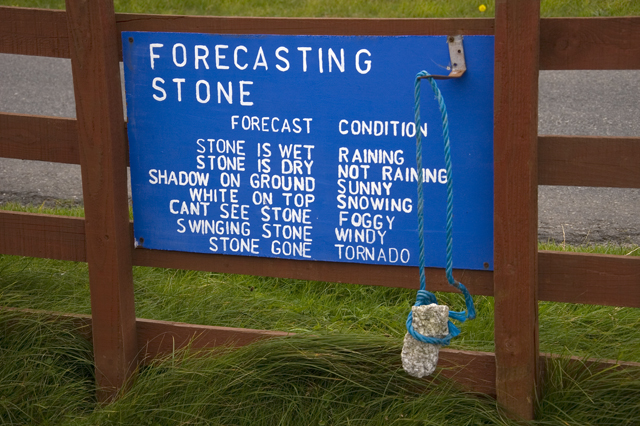August 28, 2023
Let’s say you are planning an event in a year’s time. Say it is a family reunion.
A year from now will be toward the end of summer (if you are in the Northern Hemisphere, as I am not, as it happens).
So you need to make some decisions. Should it be indoors? Maybe. It could be very hot, depending on where the event is being held. It could be extremely rainy. Maybe a thunderstorm, or even a tornado warning, with flooding rains. It almost certainly will not be snowing, unless the event is in Alaska, in which case it might be. On the other hand, wherever it is, conditions might also be beautiful and balmy.
But you have some decisions to make. What location would be most convenient? Indoors or outdoors? If it’s outdoors, maybe you need a tent, or to hold the event under some sort of pavilion to protect from sun and rain. What about catering options? Entertainment? Parking? All your planning has to be focused on these issues.
What a rigorous imagination would do in this case is to create a limited number of scenarios of this future, that capture the full range of the plausible conditions your event might face. You can have the “beautiful moderate weather” scenario. You can have a “violent thunderstorm” scenario. You can have a “boiling hot and humid” scenario. Maybe a “cool and windy” scenario. You probably do not need to include a “snow” scenario for the end of August in most of the Northern Hemisphere, because that is not within the range of the plausible.
What decisions would you make for each scenario? Well, it depends in part on your appetite for risk. Do you dream of an outdoor event, and really do not want everyone cooped up inside? Or are you the kind of folks who do not want to get wet or hot under any circumstances? Once you decide what kind of group you are, then the scenarios may tell you what to do. If you want to be outdoors, you had better plan for heavy weather – either a really heavy-duty tent that can stand up to wind, or a pavilion. If you want to be indoors, then air conditioning. And the catering options will follow from these decisions, which will be influenced by your rigorously imagining the full range of the plausible conditions you might face.
Now let’s compare this to how our leading political experts and media deal with the national “picnic” we are planning to have in November 2024: to wit, the presidential election.
We as a people do have a lot of decisions to make with respect to this “picnic.” Do we want government to do more, or less? Raise taxes, and if so, on whom? Balance the budget, or raise the deficit? Invest in infrastructure – and if so, by direct government action or through private actors? Cozy up to China or seek to impede them? Invest in more military hardware, or disinvest? And either way, in what areas? And so many other decisions that we, the people, should be thinking about.
But if you look at the news, such critical decisions, while somewhat regularly raised, do not dominate the discussion. What dominates the discussion is the horse race: Who’s going to win? Who’s up? Who’s down? Who has a chance and who doesn’t?
And one of the main ways these horse-race questions are posed and answered in our “media ecosphere” is by the opinion poll; and one of the innovations that these polls have fostered is that of the Bayesian forecast of the percentage chance of each candidate ultimately winning the presidency.
Five Thirty Eight, Nate Silver’s outfit, pioneered this approach; but Nate seems to be pulling away from such forecasts this cycle. And we may be reaching a point at which even the average citizen understands that statistical forecasting of the ultimate outcome at this early date – even with both parties’ leading candidates very, very far in front of all challengers – is pointless.
But we are still not getting the type of analysis we should be getting from our media. What would be the actual policy and national consequences of electing a Republican candidate versus re-electing Biden (or another Democrat) in 2024? This is the equivalent of asking ourselves what the consequences would be if we hold our family reunion indoors or outdoors, or if we have seafood catered or hot dogs, if we choose a near or distant location, etc. etc.
Instead, even though we are not getting as much of the “President Biden has a 47.8% chance of winning if the election were held today” sort of predictions, we are still getting the sort of polling temperature-taking that would be the equivalent of getting a weather forecast for that family reunion date, day after day, even knowing it will not mean a thing until about a week before the event, and even though we should be able to identify the political equivalent of those multiple plausible scenarios about which we need to think seriously.
I’ll start. How about a scenario in which China threatens to invade Taiwan before the 2024 election? How about a scenario in which one or both of the leading contenders at the moment are not, in fact, on the ballot in November 2024? How about a scenario in which inflation is defeated, but a recession is the result? How about a scenario in which societal cohesion is so frayed that the United States faces a large minority of the public that will refuse to accept the result of the election no matter what? And just to avoid ending on a bad note, how about a scenario in which the United States finally has an election that results in a very large and robust majority for one party or another, along with a general acceptance that the process was fair and the future looks bright?
These scenarios have nothing directly to do with the sort of polling temperature-taking and prediction that are what we get from our media day after day, week after week, month after month. But they are the type of things that we as a people may well have to deal with, and for which we all should be using our imaginations to anticipate things that might really have a huge impact on us.
Not that you would ever get that impression from either the mainstream media or the partisan outlets that have grown up around them. These media tend to treat our politics as either a sporting event to be handicapped, or as straight gambling, or else as an opportunity to manipulate eyeballs by providing clickbait content. Almost never to think through what really might face us.
This media would “prepare” you for your family reunion by constantly offering you a forecast for the date in question, far too early to be of use. They would supplement this pointless prediction with sensationalistic fearmongering “journalism” about tornadoes that could hit your outdoor reunion, food poisoning that could destroy your indoor reunion, puff pieces about venues that have given them money in return for favorable coverage, and, of course, negative coverage of venues that have not given them such emoluments. Very little in the way of rigorous imagination is on offer in our media these days.
Nate Silver’s retreat from Five Thirty Eight may betoken his recognition that this purely horse-race predictive approach has reached the end of its usefulness. And a nation of grown-ups may be coming to the conclusion that we ought to be getting something other than a hatemongering, scandal-flogging, or celebrity-reality-TV approach to our single biggest and longest-running collective decision process.
I hope that is true. We could use a bit less temperature-taking and clickbait, and a bit more sophisticated, grown-up, rigorous imagination in our politics.



